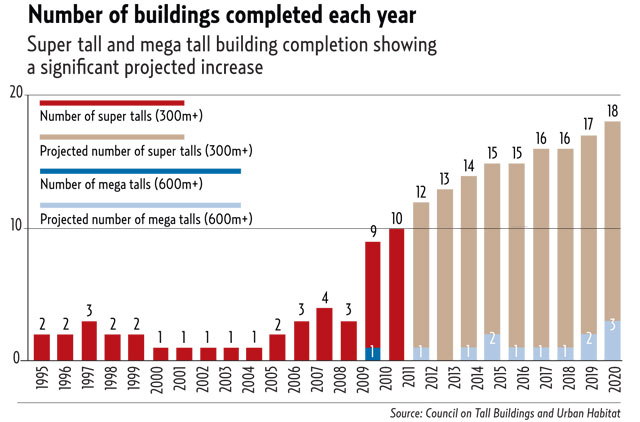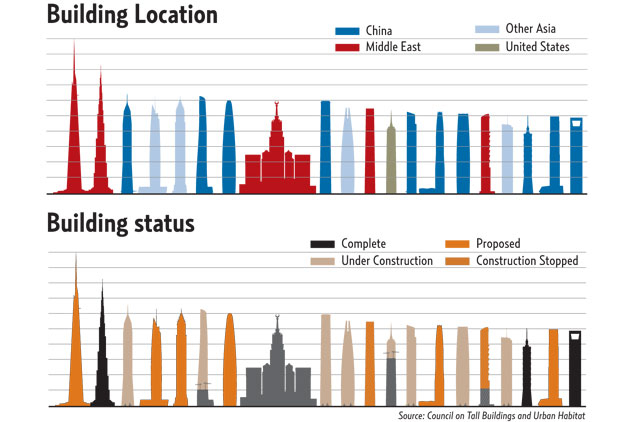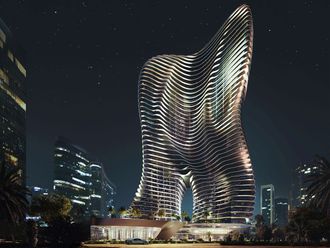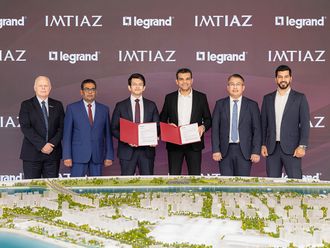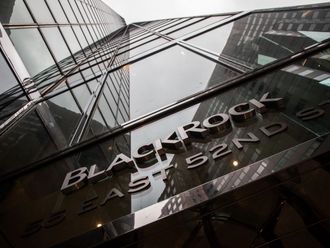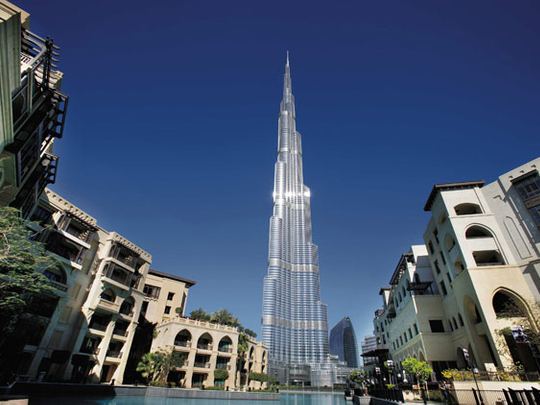
The landscape of super-tall buildings measuring more than 300 metres will drastically change by 2020, with 19 of the world's tallest buildings located in Asia and a decent number of them being developed in the UAE — especially Dubai.
As it is, the face of the urban habitat is changing fast, especially in cities located in emerging markets. Cities such as Dubai, Jeddah, Abu Dhabi, Shanghai, Hong Kong and Mumbai are set to dominate the global tall building landscape.
Five towers that will rise above 300 metres will be delivered this year. They include the 414-metre Princess Tower and 381-metre Elite Tower — both being developed by Tameer Holdings; and the 355-metre twin towers JW Marriott Marquis Hotel towers, currently being developed by Emirates Group and 23 Marina, which will rise 393 metres.
This comes a few months after the completion of the Torch — a 337-metre tower. Last year, 16 of the world's 88 completed skyscrapers over 200 metres were built in the UAE, including nine in Abu Dhabi and seven in Dubai. Of the 88, 42 were built in Asia and 27 in the Middle East. This is totally in contrast to the dominance of the metropolises in the US — such as Chicago and New York City — that dominated the global skyscraper race in the past.
"Within this decade we will likely witness not only the world's first kilometre-tall building, but also the completion of a significant number of buildings over 600 metres (around 2,000 feet) — that's twice the height of the Eiffel Tower," said the latest report by the Council on Tall Buildings and Urban Habitat (CTBUH).
The Kingdom Tower has been given the go-ahead after it received its final license, Chairman of Kingdom Holding Company (KHC) Prince Alwaleed bin Talal confirmed recently.
The SR4.6 billion Kingdom Tower, which will stand over 1,000 meters tall, is the centerpiece and the first construction phase of Kingdom City, Jeddah Economic Company's (JEC) new urban development covering more than 5.3 million square meters of land in the north of Jeddah overlooking the Red Sea and Obhur Creek. Work on the project began on Jan. 1.
Super Tall
"Two years ago, prior to the completion of the Burj Khalifa, this building type did not exist. And yet, by 2020, we can expect at least eight such buildings to exist internationally. The term "super tall" (which refers to a building over 300 metres) is thus no longer adequate to describe these buildings: we are entering the era of the mega tall. This term is now officially being used by the Council to describe buildings over 600 metres in height, or double the height of a super tall.
When the world moved into the 21st century, the Petronas Towers held the title of the world's tallest at 452 metres (1,483 feet).
Taipei 101 took the title in 2004, at 508 metres (1,667 feet). Then, at the end of the decade, the Burj Khalifa set new standards at 828 metres (2,717 feet) — over 800 meter.
"Now, with work set to start on-site this year for Jeddah's 1,000+ metre Kingdom Tower, we can expect that in a mere two decades (2000-2020) the height of the world's tallest building will have more than doubled," the report said.
What is perhaps the most interesting aspect of the study is that the previous world's tallest towers mentioned in the chart above now barely make the list. In just two decades, Petronas will have gone from 1st to 27th tallest in the world, and Taipei 101 just scrapes into the study in 18th place. "The government of Dubai has a vision to position Dubai as the most modern city in the world — so all developers also follow this vision and race to develop skyscrapers with the best designs and quality of work," Tameer president Federico Tauber, told Gulf News.
His company is delivering two super tall towers — Princess Tower and Elite Towers — both coming up at Dubai Marina.
Tremendous change
While the new projects taken into account (that are not included in the study) will surely be announced and built throughout the decade, one can predict that, with the exception of the Burj Khalifa and Makkah Royal Clock Tower, all of the tallest 20 buildings in 2020 have yet to be built.
The tremendous change that the tall building industry has seen in two decades is clearly shown by a juxtaposition of three skylines: the tallest 20 buildings in the year 2000, 2010, and 2020.
It is also useful to understand the tallest 20 in 2020 in the context of global tall building trends. The average height of these 20 buildings is predicted to be 598 metres precisely.
Yet, as we stand at the beginning of 2012, there are actually only 61 buildings over 300 metres (the threshold for super tall). Many of these are located in Dubai.
One would wonder why countries in Asia and the Middle East are racing against each other to build these super tall buildings. "There are many factors involved in the decision to build a super tall building. There are certainly huge economic factors, which contribute to the feasibility to these structures," Nathaniel Hollister, a CTBUH spokesperson, told Gulf News.
Burj effect
"It is important to remember that many of these factors are more comprehensive than simply the building itself. For instance, an iconic super tall building often has the effect of increasing the property value of buildings in its vicinity referred to as the ‘Burj effect'. "Another reason that places like Asia and the Middle East are pressing ahead with super tall design is to establish an economic presence internationally. For instance, there is a very strong feeling in Seoul that the city lacks the signature buildings that other cities contain.
"A third factor, more influential in Asia than the Middle East, is density. Many Asian cities are increasing at a phenomenal rate, and super tall buildings are one way to cope with this increase."
Until recently, in fact, the completion of a super tall was rather a rare occurrence, with only 15 super tall towers completing in the 65 years between the world's first such building (New York's Chrysler Building, 1930) and 1995. It was only in the mid-1990s that it became common for more than one Super Tall to be added to the lists annually, with 1995 being the last year when no super talls were completed. Now, less than two decades later, the number of super talls completed annually has entered double digits and is set to rise further.
Meanwhile, the number of mega tall towers set to complete in the current decade is similar to the number of super talls completed in the 90s. In terms of height, therefore, 600 metres seems to be the ‘new 300 metres'.
Not only increasing in height, the tallest 20 in 2020 also demonstrate a diversity in project location not previously seen in the world's tallest 20. The projects are scattered across 15 cities in seven countries. China, with 10 of the 20 projects, clearly stands out as the country most rapidly pursuing super tall, followed by Korea (three), Saudi Arabia (two), and the UAE (two).
North America
If we analyse via a larger geographic region, however, the picture becomes even more pronounced. Asia (not including the Middle East) accounts for 70 per cent of buildings (14). The Middle East counts for 25 per cent (five).
The only other region to be represented in the study is North America, where New York's One World Trade Centre is the only tower in the western hemisphere to make the list. If we consider the Middle East as part of continental Asia, then Asia contains 19 of the 20 projects.
However, the big question is: why are super tall buildings not built in Western countries as often as they used to be?
"Many cities in the western world have been building high-rise structures for over 100 years and have established themselves internationally. Additionally, western cities are not undergoing the same incredible increase currently under way in Asia," Hollister said. "Thus, there are fewer reasons to build super tall in the western world. It is also helpful to remember that western cities are continuing to build tall, though not at the same rate as Asia or the Middle East."
Dubai topped the list of global cities in terms of completing the number of skyscrapers — those rising more than 200 metres — in 2010, CTBUH statistics show. The emirate currently has 17 of the world's tallest 100 towers, followed by Hong Kong with nine, Shanghai with eight, New York City and Chicago with seven each.
"This is indicative of the rapid rate at which so many Asian cities are developing," CTBUH chairman Professor Sang Dae Kim, said in a recent statement. The UAE, as a country, is ranked second to China, the CTBUH report shows. Five of the tallest 10 completed towers in 2010 were in the UAE, including four in Dubai and one in Abu Dhabi. These include Burj Khalifa — the world's tallest tower and Rose Reyhaan Rotana — the world's tallest hotel tower.
The UAE had 14 skyscrapers completed in 2010 with the sum of heights touching 4,196 metres, out of 66 in the world — with the total heights reaching 16,828 metres. China led the global list with 21, while South Korea hosts eight, followed by the United States and Singapore, which completed six each. However, 55 out of the 66 towers were completed in Asian countries.
Dramatic increase
Of the 14 towers completed in the UAE, two are located in Abu Dhabi and one in Ajman, CTBUH research shows.
"The recent dramatic increase in tall buildings has been fuelled by a large variety of local and global motivations, and therefore cannot be directly related to any single factor," the report said.
"The historical and statistical contexts of the "tall typology" thus vary dramatically across the globe. At one end of the spectrum is the UAE, which can now boast 44 buildings over 200 metres in height. For a country of 4.7 million people, this means that there are only 100,000 citizens for every 200 metres building. In contrast, China, with 200 buildings at the 200 metres level, has nearly seven million citizens for every 200 metres building. Perhaps unsurprisingly, the research demonstrates that the lowest population-to-building ratios can be found in Middle Eastern countries such as the UAE, Bahrain and Qatar."
The race for building the world's tallest tower started nearly a century ago, with two 200-metre plus towers completed in the 1920s, while six were completed in 1930s, with the Empire State Building setting a new landmark that lasted more than 41 years until Sears (Now Willis) Towers snatched the record in 1973 — tilting the balance of concentration of high-rise towers from New York to Chicago.
The projected 20 tallest buildings in 2020, all of which are over 500 metres, including eight that can be classified as ‘mega tall' (600 metres)
Doha Convention Centre and Tower
- Doha, Qatar
- Height: 551 m/1,808 ft
- Current status: Construction stopped
- Completion date: Unknown
- Building use: Residential/hotel
- Structural material: Steel/concrete
- Total floors: 112
- Owner/developer: Qatari Diar Real Estate Investment Co
Kingdom Tower
- Jeddah, Saudi Arabia
- Height: 1,000 + m/3,280 + ft
- Current status: Under construction
- Completion date: 2018
- Use: Hotel/residential/office
- Structural material: Concrete
- Total floors: 156
- Owner/developer: Jeddah Economic Company
Burj Khalifa
- Dubai, UAE
- Height: 828 m/2,717 ft
- Current status: Completed
- Completion date: 2010
- Use: Office/residential/hotel
- Structural material: Steel/concrete
- Total floors: 163
- Owner/developer: Emaar Properties PJSC
Ping An Finance Centre
- Shenzhen, China
- Height: 660 m/2,165 ft
- Current status: Under construction
- Completion date: 2015
- Use: Office
- Structural material: Composite
- Total floors: 115
- Owner/developer: Ping An Life Insurance Company of China
Seoul Light DMC Tower
- Seoul, South Korea
- Height: 640 m/2,101 ft
- Current status: Proposed
- Completion date: 2017
- Use: Hotel/residential/office
- Structural material: Composite
- Total floors: 130
- Owner: Seoul Light AMC
- Developer: Millennium Builder
Signature Tower Jakarta
- Jakarta, Indonesia
- Height: 638 m/2,093 ft
- Current status: Proposed
- Completion date: 2016
- Use: Hotel/office
- Structural material: Composite
- Total floors: 111
- Owner/developer: PT Grahamas Adisentosa
Shanghai Tower
- Shanghai, China
- Height: 632 m/2,073 ft
- Current status: Under construction
- Completion date: 2014
- Building use: Hotel/office
- Structural material: Composite
- Total floors: 121
- Owner/developer: Shanghai Tower Construction & Development
Wuhan Greenland Centre
- Wuhan, China
- Height: 606 m/1,988 ft
- Current status: Proposed
- Completion date: 2015
- Building use: Hotel/residential/office
- Structural material: Composite
- Total floors: 118
- Owner/developer: Wuhan Greenland Bin Jiang Property Co Ltd
Makkah Royal Clock Tower Hotel
- Makkah, Saudi Arabia
- Height: 601 m/1,972 ft
- Current status: Topped out
- Completion date: 2012
- Building use: Hotel
- Structural material: Steel/concrete
- Total Floors: 120
- Owner/developer: Saudi Bin Ladin Group
Goldin Finance 117
- Tianjin, China
- Height: 597 m/1,957 ft
- Current status: Under construction
- Completion date: 2015
- Building use: Hotel/office
- Structural material: Composite
- Total floors: 128
- Owner/developer: Goldin Properties Holdings Ltd
One World Trade Centre
- New York City, USA
- Height: 541 m/1,776 ft
- Current status: Under construction
- Completion date: 2013
- Use: Office
- Structural material: Composite
- Total floors: 104
- Owner: 1 World Trade Centre LLC
- Developer: Port Authority of New York & New Jersey
The CTF Guangzhou
- Guangzhou, China
- Height: 530 m/1,739 ft
- Current status: Under construction
- Completion date: 2017
- Use: Hotel/residential/office
- Structural material: Composite
- Total floors: 111
- Owner: Chow Tai Fook Enterprises
- Developer: New World Project Management
Tianjin Chow Tai Fook Binhai Centre
- Tianjin, China
- Height: 530 m/1,739 ft
- Current status: Proposed
- Completion date: 2015
- Use: Residential/hotel/office
- Structural material: Composite
- Total floors: 97
- Owner/developer: New World China Land
Shanghai World Financial Centre
- Shanghai, China
- Height: 492m/1,614ft
- Current status: Completed
- Completion date: 2008
- Use: Hotel/office
- Structural material: Composite
- Total floors: 101
- Owner: Shanghai World Financial Centre Co. Ltd.
- Developer: Mori Building
Lotte World Tower
- Seoul, South Korea
- Height: 555 m/1,819 ft
- Current status: Under construction
- Completion date: 2015
- Building use: Hotel/office
- Structural material: Composite
- Total floors: 123
- Owner/developer: The Lotte Group
Dalian Greenland Centre
- Dalian, China
- Height: 518 m/1,699 ft
- Current status: Under construction
- Completion date: 2016
- Use: Hotel/residential/office
- Structural material: Composite
- Total floors: 88
- Owner/developer: Greenland Group
Pentominium
- Dubai, UAE
- Height: 516 m/1,693 ft
- Current status: Construction Stopped
- Completion date: To be confirmed
- Use: Residential
- Structural material: Steel/concrete
- Total floors: 122
- Developer: Trident International Holdings
Busan Lotte Town Tower 18
- Busan, South Korea
- Height: 510 m/1,674 ft
- Current status: Under construction
- Completion date: 2016
- Use: Residential/hotel/office
- Structural material: Composite
- Total floors: 107
- Owner/developer: The Lotte Group
Taipei 101
- Taipei, Taiwan, PRC
- Height: 508m/1,667ft
- Current status: Completed
- Completion date: 2004
- Use: Office
- Structural material: Composite
- Total floors: 101
- Owner/developer: Taipei Financial Centre Corporation
Kaisa Feng Long Centre
- Shenzhen, China
- Height: 500m/1,640ft
- Current status: Proposed
- Completion date: To be confirmed
- Use: Hotel/office
- Structural material: Composite
- Total floors: 92
- Owner/developer: Kaisa Group Holdings


